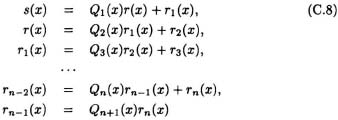C.3 EUCLIDEAN GCD ALGORITHM FOR POLYNOMIALS
Theorem C.3.1 (Division Algorithm for Polynomials) For 2 polynomials c(x) and d(x) with d(x) not equal to zero, there is a unique pair of polynomials Q(x) (the quotient polynomial) and r(x) (the remainder polynomial) such that
![]()
and deg r(x) < deg d(x).
Theorem C.3.2 (Euclidean GCD Algorithm for Polynomials) Given the polynomials s(x) and r(x) over certain field, their greatest common divisor can be computed by applying iteratively the division algorithm. Suppose deg s(x) ≥ deg r(x) ≥ 0, then this computation is carried out iteratively as:

and the process stops when a remainder of zero is obtained. Then
![]()
where α is a scalar.
Corollary C.3.1 For any polynomials s(x) and r(x), there exist polynomials a(x) and b(x) such that
![]()
The procedure to find the polynomials a(x) and b(x) is the same as that for the integers.
Example C.3.1 Find GCD(s(x),r(x)), given s(x) = x3 − x2 + x − 1 and r(x) = x2 − 2x + 1. Express GCD(s(x),r(x)) in terms of s(x) and r(x) as in(C.10).
From Euclidean algorithm, we have
Therefore, GCD(s(x), r(x)) = 2(x − 1). By using ...
Get VLSI Digital Signal Processing Systems: Design and Implementation now with the O’Reilly learning platform.
O’Reilly members experience books, live events, courses curated by job role, and more from O’Reilly and nearly 200 top publishers.

